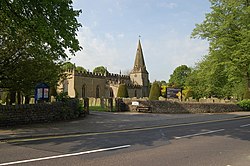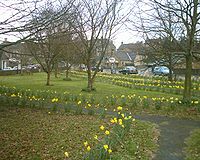Baslow
| Baslow | |
| Derbyshire | |
|---|---|
 Parish church | |
| Location | |
| Grid reference: | SK252723 |
| Location: | 53°14’53"N, 1°37’23"W |
| Data | |
| Population: | 1,178 |
| Post town: | Bakewell |
| Postcode: | DE45 |
| Local Government | |
| Council: | Derbyshire Dales |
| Parliamentary constituency: |
Derbyshire Dales |
Baslow is a village in Derbyshire, in the Peak District, situated between Sheffield and Bakewell, just over a mile north of Chatsworth House. It is sited by the River Derwent, which is spanned by a 17th-century bridge, alongside which is a contemporary toll house.
Baslow village is composed of several distinct areas: Bubnell, Bridge End, Over End and Nether End. The village's civil parish is called Baslow and Bubnell, which in the 2011 census had a population of 1,178.
Contents
History
St Anne's Church has an Anglo-Saxon coffin lid in the porch entrance, but the oldest part of the current building, the north aisle, dates from about 1200. The tower was constructed in the 13th century but the rest of the church is newer and was the subject of an extensive restoration in the 19th century. A sundial lies in the church grounds, atop the shaft, base and steps of a cross. This may have acted as a market cross in the 17th century. A second cross lies in the graveyard, moved from Bubnell by Doctor Wrench, who erected the nearby Wellington Monument and is buried in the churchyard. This cross may historically have been known as the "Butter Cross".[1]
Just behind the church is the old bridge. Built in 1603, this is the oldest bridge across the Derwent never to have been destroyed by floods.
The Baslow Grand Hotel Golf Club (now defunct) was founded in 1896. The course was still appearing on Ordnance Survey maps in the 1930s.[2]
Geography
Baslow village is composed of several distinct areas: Bubnell (west of the river), Bridge End (by the river crossings), Over End (north of the main road) and Nether End (adjacent to Chatsworth Park).
Bridge End is the original settlement, clustered around the church and the ancient bridge and ford across the River Derwent.
Nether End, at the eastern end of the village, has several hotels, pubs, restaurants and tea rooms. There is also a caravan site and a pedestrian entrance to Chatsworth Park. Just outside Nether End (and the village itself) are the so-called "Golden Gates", a set of gates dating from the 1st Duke's rebuilding of Chatsworth, which were moved here by Sir Joseph Paxton for William Cavendish, 6th Duke of Devonshire, in the 19th century to make a new entrance to the park, following its extension northwards towards Baslow in the 1830s. The gates are now only rarely used, most usually when large public events are held in the park.
Over End is a residential area on the hillside to the north of the village. It contains Baslow Hall, just off Calver Road, which was once occupied by Sebastian Ziani de Ferranti, the radio and electrical pioneer and inventor, and next by George Kenning. Today it is Fischer's Restaurant. Near the junction of Bar Road and Gorse Bank Lane was the site of a large Hydropathic hotel, which was demolished in 1936 and is now a small cul-de-sac called Hydro Close.
To the north of the village, Baslow Edge was once quarried for gritstone and features the Eagle Stone, an isolated block of gritstone 20 feet high. According to tradition, the local men had to climb this rock before they were worthy of marriage. Just behind it there is a monument to the Duke of Wellington, raised in 1866 by the local dignitary, Dr Lieutenant Colonel E. M. Wrench. It marked an earlier visit by Wellington to the moor, and was also intended as a balance to the nearby Nelson's Monument.[1]
Outside links
| ("Wikimedia Commons" has material about Baslow) |
- Baslow description page from Discover Derbyshire
- Baslow walk: Discover Derbyshire
- Information on Baslow from GENUKI
- Baslow in the Domesday Book
References
- ↑ 1.0 1.1 Sharpe, Neville T. (2002). Crosses of the Peak District. Ashbourne: Landmark Collectors Library. ISBN 1843060442.
- ↑ “Baslow Grand Hotel Golf Club”, “Golf’s Missing Links”.
